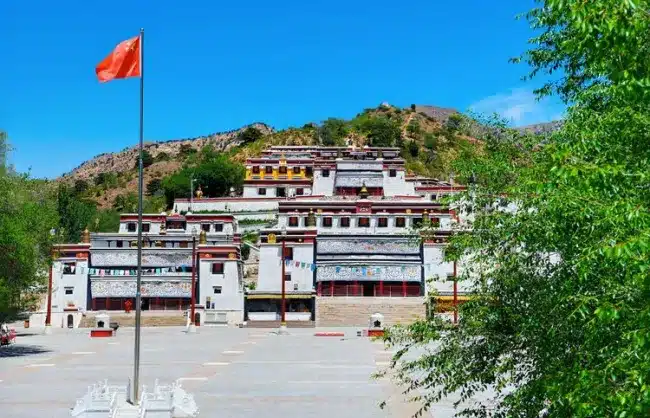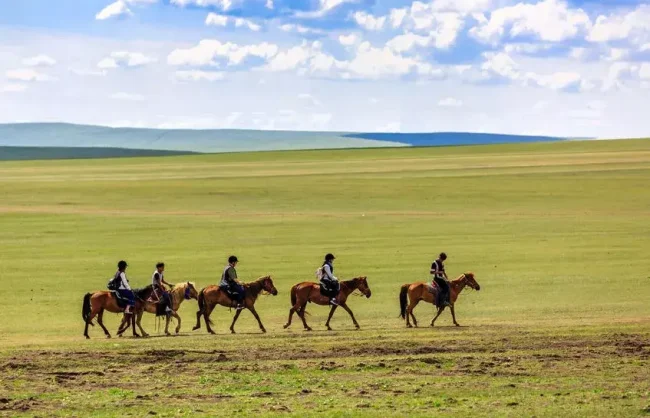Wudangzhao Monastery (aka Wudangzhao Temple) is located in the depths of Daqing Mountain in the Wudang Gully of Jihuluntu Sumu, about 45 kilometers northeast of Shiguai District, Baotou City, Inner Mongolia. It is one of the four famous Tibetan Buddhist monasteries in China, as well as the largest and most well-preserved Tibetan Lamasery in Inner Mongolia.
Wudangzhao, “Wudang” meaning “willow tree” in Mongolian, is originally named Badaga’er Zhao, among which “Badaga’er” means “white lotus flower” and “Zhao” means “temple” in Tibetan. Founded by the first Living Buddha Rob Sangalatuo during the Kangxi reign of the Qing Dynasty (1662-1722), Wudangzhao Monastery was renovated in 1749 during the Qianlong reign and given a Chinese name Guangjue Temple. Over time, it has undergone multiple expansions and gradually formed its scale today.
Wudangzhao Monastery has more than 2,500 halls, sutras and monks’ residences, covering an area of over 300 acres and distributed on a 1.5-kilometer-long hillside. It is a white building complex surrounded by mountains and nestled by lush pine and cypress trees, very majestic and spectacular. Known as “the First Temple on the Northern Grassland” and “the Potala Palace on the Grassland“, Wudangzhao Monastery is a popular tourist attraction for visitors seeking to appreciate Tibetan Buddhist culture and scenery.
Facts About Wudangzhao Monastery
- Location: at the southern foot of Jihuluntu Mountain, Shiguai District, Baotou City, Inner Mongolia
- Opening hours: 08:30-17:45
- Ticket price: 60 RMBper person
- Time needed: 2-3 hours
- Best season to visit: June to September
- Suited to: anyone who loves Tibetan culture, religion, architecture, and art

What to See and Do in Wudangzhao Monastery
Wudangzhao Monastery is built layer by layer against the mountain, with a rigorous layout, magnificent architecture, and full of unique Tibetan style. The main building complex of Wudangzhao Monastery consists of six main halls, three living Buddha mansions, and a pagoda tomb (that houses the relics of several living Buddhas).
Among them, Suguqin Hall, the largest building in Wudangzhao Monastery, is the gathering place for chanting sutras throughout the temple. All big events and assemblies are held here. The sculptures, murals, and thangkas inside the hall not only showcase the superb artistic level and rich religious connotations, but also serve as precious materials for studying minority cultures.
Dongkuoer Hall, the earliest hall in Wudangzhao Monastery, is a place for teaching astronomy and geography, with a plaque of “Guangjue Temple” written in four languages: Han, Manchu, Mongolian, and Tibetan hanging on the door header.
Wudangzhao Monastery is not only a Buddhist holy site, but also the academic center of Tibetan Buddhism in Inner Mongolia. There are four major departments here, which cultivate numerous talents in Lamaism and serve as an important window for understanding Tibetan Buddhist culture.
Every year on the 21st day of the third lunar month, Baotou Wudangzhao Monastery holds a spring festival, and traditional activities such as horse racing, archery, and wrestling attract a large number of people to travel to Baotou, Inner Mongolia and watch.
In addition, Wudangzhao Temple in Inner Mongolia is also a paradise for photography enthusiasts. Whether it’s ancient buildings, peaceful mountains or Buddhist art, they can all become stunning images under your lens.

Wudangzhao Monastery Visiting Tips
- Please keep quiet during the visit. Respect the basic etiquette and customs of Buddhism: Do not step on the thresholdat the entrance of the temple, you should cross it; Photography is prohibited in the Bodhisattva area enshrined in the main hall.
- During yourInner Mongolia tours, always take sun protection measures and prepare a jacket to cope with temperature changes.
Getting to Wudangzhao Monastery
After arriving in Baotou City, you are advised to drive a car or take a taxi to Wudangzhao Monastery, which takes around 1.5 hours.
Attractions Nearby Wudangzhao Monastery
- Xilamuren Grassland: a vast grassland where youcan experience the traditional Mongolian lifestyle, ride horses, and stay in yurts, located about 130 kilometers from Wudangzhao Monastery.
- Genghis Khan’s Mausoleum: a grand complex dedicated to the legendary Mongol ruler and his achievements,located about 200 kilometers from Wudangzhao Monastery.
- Zhao Great Wall: an ancient section ofthe Great Wall in China which dates back to the 4th century BC, located about 30 kilometers from Wudangzhao Monastery.










